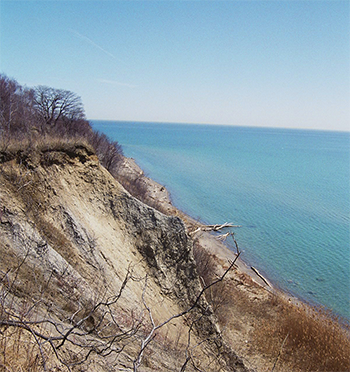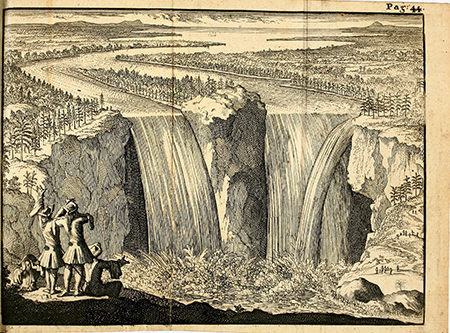Nundawao
 Just after sunrise a young Seneca youth called Nundawo arrived at the shoreline of the lake called Ontarí’io. Rays of sun started appearing just along the eastern horizon of the “Great Lake” and barely warmed the cool morning air. But the dugout canoe was in the water now. Supplies for a day’s journey lined the bottom and a paddle leaned against the seat as he steadied the canoe to hop in.
Just after sunrise a young Seneca youth called Nundawo arrived at the shoreline of the lake called Ontarí’io. Rays of sun started appearing just along the eastern horizon of the “Great Lake” and barely warmed the cool morning air. But the dugout canoe was in the water now. Supplies for a day’s journey lined the bottom and a paddle leaned against the seat as he steadied the canoe to hop in.
The young Seneca eased into his boat, dipped his paddle into the clear cold waters and pushed off anticipating a good day’s fishing. Sporting his traditional long, flowing hair, he is dressed for the occasion to stay warm out in the water in his dugout canoe. He wore deer skin leggings, ankle high moccasins, a knee length deerskin overcoat and a matching headband. This wasn’t the first time he set off on an very early morning fishing trip but it was the first time heading west along the shoreline. It was his job to catch fish for his family and yesterday he didn’t catch enough by travelling east along the shore. This time he thought heading west might be better, although he knew he would be leaving Seneca territory and possibly encounter Neutrals. But his family needed the fish and duty was for the Seneca as important as life itself.
And so, he began his day’s work paddling west along the coast for several hours until he found some favourable fishing grounds. Gazing into the waters he cast out his net and began pulling it in. After an hour or so of repeating this, not a single fish found a new home at the bottom of the canoe. What to do?
He sat down and started paddling further west searching the waters but today the fish were nowhere to be seen. Not a problem, he thought. He continued paddling along the coast moving further west hoping to spot a school of fish close to the surface to spear several dozen. He managed to catch a few here and there but not a good day’s work. Now he was far from Seneca lands heading deep along the shore into Neutral lands.
 In an hour or so the current started picking up, the wrong way. Paddling harder he eventually reached the mouth of a fast flowing river that he knew led upstream to the thunderous noise and enormous clouds of the great cataract known as Jaonniaka-re. Paddling hard to reach the the opposite shoreline he paused to rest at a rocky outcropping. Looking inland he spotted a small camp with a fire and a group of people moving about it. Sensing danger, he quickly paddled west just beyond the river hugging the shoreline until he spotted a thick school of fish. Not wasting any time, he quickly managed to catch enough fish for his efforts and quickly spun around to head home.
In an hour or so the current started picking up, the wrong way. Paddling harder he eventually reached the mouth of a fast flowing river that he knew led upstream to the thunderous noise and enormous clouds of the great cataract known as Jaonniaka-re. Paddling hard to reach the the opposite shoreline he paused to rest at a rocky outcropping. Looking inland he spotted a small camp with a fire and a group of people moving about it. Sensing danger, he quickly paddled west just beyond the river hugging the shoreline until he spotted a thick school of fish. Not wasting any time, he quickly managed to catch enough fish for his efforts and quickly spun around to head home.
As he approached the river’s mouth, the inevitable happened. Heading fast towards him were several canoes each carrying some very agitated men shouting to him in a familiar but somewhat different language - but not shouting any war cries. It seems he was noticed by the people in the camp as he crossed the river to its western shore. All were members of the Onguiaahra tribe, what the French explorers would later call Neutrals because they considered themselves peacemakers between the Wyandot (Huron) and the Iroquois.
What - they wanted to know - was a young Seneca man doing catching fish so far from home. They didn’t seem to have any desire to capture him as a prisoner. They didn’t want any trouble and wanted to know the purpose of this excursion deep into Neutral territory. Certainly they were surprised to see a Seneca, although not entirely unexpected as the Seneca lived on the western end of Iroquois territory. Whatever the case, this young man demonstrated some courage and more importantly - Iroquois negotiating skills. He gave them all his fish and after profusely apologizing for intruding on their territory, they let him return across the river and back to Seneca territory.
After several hours of hard paddling, but at least with an empty boat to make it light, he reached his landing spot within Seneca territory. Feeling both relieved but angry that he lost his catch, he pulled his canoe up out of the water and hid it in the bushes for his next trip. He made his way back to his village running at night through the forests and meadows until he reached the palisades of his village. Entering the longhouse as quietly as he could he slipped into his bed on his bunk. In the morning he will try again but this time he will head east. Let’s leave him now for the time being as I am sure his family and elders might have a few tasty words for his lack of sense and empty hands in the morning.
About Nundawao
Nundawao was one of the earliest Seneca settlements located at the southern end of Canandaigua Lake. After the Seneca were forced off their ancestral land by American settlers, this Seneca village and the hill upon which is stood (Bare Hill) was soon forgotten and was even used as a source of road fill. It’s significance as a historical settlement is marked only by a road plaque. Today it has been completely absorbed into the town of Naples, New York which was founded in 1790.